Hamster
| Hamster Fossil range: Middle Miocene - Recent |
||||||||||||||||
|---|---|---|---|---|---|---|---|---|---|---|---|---|---|---|---|---|
Roborovski hamster (Phodopus roborovskii)
|
||||||||||||||||
| Scientific classification | ||||||||||||||||
|
||||||||||||||||
| Genera | ||||||||||||||||
|
Mesocricetus |
Hamsters are rodents belonging to the subfamily Cricetinae. The subfamily contains about 18 species, classified in six or seven genera.
The name hamster is derived from the German word Hamster, itself from earlier OHG hamustro, from ORuss choměstorǔ, which is either a blend of the root of Russ khomiak "hamster" and a Baltic word (cf. Lith staras "hamster")[1] or of Iranian origin (cf. Av hamaēstar "oppressor")[2].
Behavior can vary depending on their environment, genetics, and interaction with people. Because they are easy to breed in captivity, hamsters are often used as lab animals in more economically developed countries. Hamsters have also become established as popular small pets.
Hamsters are crepuscular. In the wild, they burrow underground in the daylight to avoid being caught by predators. Contrary to popular belief they are a nocturnal animal. Their diet contains a variety of foods, including dried food, berries, nuts, fresh fruits and vegetables. In the wild they will eat any wheat, nuts and small bits of fruit and vegetables that they might find lying around on the ground, and will occasionally eat small insects such as small crickets or mealworms. They have elongated fur-lined pouches on both sides of their heads which extend to their shoulders, which they stuff full of food to be brought back to the colony or to be eaten later.
Contents |
Characteristics
Hamsters are stout-bodied, with tails much shorter than body length and have small furry ears, short stocky legs, and wide feet. Their thick, silky fur, which can be long or short, can be black, grey, white, brown, buff, yellow, "sapphire" or red depending on the species, or a mix of any of those colors.
Two of the dwarf hamsters belonging to the genus Phodopus (Phodopus campbelli, Campbell's Dwarf Hamster, and Phodopus sungorus, the Winter White Russian Dwarf Hamster) and also two of the species of the genus Cricetulus, (Cricetulus barabensis, the Chinese Striped Hamster, and Cricetulus griseus, the Chinese Dwarf Hamster) have a dark stripe down the middle of the back. The species of genus Phodopus are the smallest, with bodies 5 to 10 cm (about 2 to 4 inches) long; the largest is the common hamster (Cricetus cricetus), measuring up to 34 cm (about 13 inches) long, not including a short tail of up to 4 cm (1-1/2 inches). The Angora hamster, also known as the long-haired or Teddy Bear hamster, which is a type of the Syrian Hamster is the second largest hamster breed, measuring up to 15 cm (about 6 inches) long.
The tail is often difficult to see; usually it is not very long, and on a long haired hamster it is barely visible. Hamsters are very flexible, and their bones are somewhat fragile.
Habitat
Hamsters' northern range extends from central Europe through Siberia, Mongolia, and northern China to Korea. The southern portion of their range stretches from Syria to India. Throughout dry, open country they inhabit desert borders, vegetated sand dunes, shrubby and rocky foothills and plateaux, river valleys, and mountain steppes; some live among cultivated crops. Geographic distribution varies greatly between species. The common hamster, for example, is found from central Europe to western Siberia and northwestern China, but the golden hamster has been found only near a small town in northwestern Syria.[3]
Diet
Hamsters are omnivorous. Their diet consists mostly of grains (such as whole grain oats and corn) but also includes fresh fruit, roots such as carrots, green parts of plants. Hamsters carry food in their spacious cheek pouches to a cache in the burrow. Hamsters in the Middle East have been known to hunt in packs to find insects for food.[3]
Pet stores sell a variety of treats that are suitable for hamsters.
Behavior
Syrian hamsters (Mesocricetus auratus) are generally solitary and will fight to the death if put together, whereas some of dwarf hamster species can get along with others of the same species. Hamsters are primarily considered crepuscular and at one point were considered nocturnal as they are sometimes active all night. Some species have been observed to be more nocturnal than others. All hamsters are excellent diggers, constructing burrows with one or more entrances and with galleries that are connected to chambers for nesting, food storage, and other activities. They will also appropriate tunnels made by other mammals; the Winter White Russian Dwarf Hamster (Phodopus sungorus), for instance, uses paths and burrows of the pika. None hibernate during winter, but some (mostly Syrian hamsters) experience periods of torpor lasting from a few days to several weeks. This probably means that conditions are too cold for them. Hamsters are known to stockpile large amounts of food, because of natural instinct from the wild. Because of this behavior it is possible to leave a hamster alone for a few days. Once a Syrian hamster is tamed, they remain so for a long time. However, dwarf hamsters must be continuously played with otherwise if left alone for a maximum of two to three weeks, it can become untame again.[3]
Reproduction
Hamsters become fertile at different ages dependent on their species, but this can be from one month to three months of age. Male hamsters remain fertile for the rest of their lives, though females do not. Females are in heat approximately every four days.
Breeding season is from April to October, with two to five litters of 1 to 13 young being born after a gestation period of 16 to 23 days.[3] Gestation lasts 16 to 18 days for Syrian hamsters, 18 to 21 days for the Russian hamsters, 21 to 23 days for Chinese hamsters and 23 to 30 for Roborovski Hamsters. The average litter for Syrians is about 7, but can be as great as 24, which is the maximum number of pups that can be contained in the uterus. Campbell's Dwarf Hamsters tend to have 4 to 8 in a litter but can have up to 14. Winter White Russian Dwarf Hamsters tend to have slightly smaller litters, as do Chinese and Roborovski hamsters.
Siberian hamsters form close, monogamous bonds with their mates. If separated, they may become very depressed. This happens especially in males. Males will become inactive, eat more, and even show some behavioral changes similar to some types of depression in humans. This can even cause obesity in the hamster.
Chinese hamster females are known for being aggressive toward the male if kept together for too long. In some cases, male Chinese hamsters have died after being attacked by the female. If breeding Chinese hamsters, it is recommended to separate the pair after mating or the hamsters will attack each other.
Hamsters are born hairless and blind in a nest which the mother will have prepared in advance. She uses shredded material such as leaves in the wild but prefers cotton or toilet paper in captivity. After one week they begin to explore outside the nest. They are completely weaned after three weeks, or four for Roborovski Hamsters. Most breeders will sell the hamsters to shops when the hamsters are anywhere from two to eight weeks old.
Classification
Taxonomists generally disagree about the most appropriate placement of the subfamily Cricetinae within the superfamily Muroidea. Some place it in a family Cricetidae that also includes voles, lemmings, and New World rats and mice; others group all these into a large family called Muridae. Their evolutionary history is recorded by 15 extinct fossil genera and extends back 11.2 million to 16.4 million years to the Middle Miocene Epoch in Europe and North Africa; in Asia it extends 6 million to 11 million years. Four of the seven living genera include extinct species. One extinct hamster of Cricetus, for example, lived in North Africa during the Middle Miocene, but the only extant member of that genus is the common hamster of Eurasia.
- Subfamily Cricetinae
- Genus Allocricetulus
- Species A. curtatus - Mongolian Hamster
- Species A. eversmanni - Kazakh Hamster, also called Eversmann's Hamster
- Genus Cansumys
- Species C. canus - Gansu Hamster
- Genus Cricetulus
- Species C. alticola - Ladak Hamster
- Species C. barabensis, including "C. pseudogriseus" and "C. obscurus" - Chinese Striped Hamster, also called Chinese Hamster; Striped Dwarf Hamster
- Species C. griseus - Chinese (Dwarf) Hamster, also called Rat Hamster
- Species C. kamensis - Tibetan Hamster
- Species C. longicaudatus - Long-tailed Hamster
- Species C. migratorius - Armenian Hamster, also called Migratory Grey Hamster; Grey Hamster; Grey Dwarf Hamster; Migratory Hamster
- Species C. sokolovi - Sokolov's Hamster
- Genus Cricetus
- Species C. cricetus - European Hamster, also called Common Hamster or Black-Bellied Field Hamster
- Genus Mesocricetus - Golden Hamsters
- Species M. auratus - Syrian Hamster, also called the Golden Hamster or "Teddy Bear" hamster
- Species M. brandti - Turkish hamster, also called Brandt's Hamster; Azerbaijani Hamster
- Species M. newtoni - Romanian Hamster
- Species M. raddei - Ciscaucasian Hamster
- Genus Phodopus - Dwarf Hamsters
- Species P. campbelli - Campbell's Russian Dwarf Hamster
- Species P. roborovskii - Roborovski Hamster, the smallest and fastest of the hamster species
- Species P. sungorus - Winter White Russian Dwarf Hamster
- Genus Tscherskia
- Species T. triton - Greater Long-tailed Hamster, also called Korean Hamster
- Genus Allocricetulus
Pet ownership
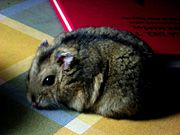
A Russian dwarf hamster

A Roborovski Dwarf Hamster
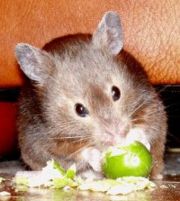
A Sable short-haired Syrian Hamster
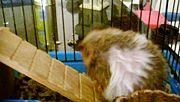
A brown and white Syrian Hamster grooming itself after a dust bath. Hamsters can not be given water baths, it can stress them out and cause wet tail, and it also increases the risk of them catching pneumonia.
|
The best-known species of hamster is the Syrian or Golden Hamster (Mesocricetus auratus), which is the type of hamster most commonly kept as a pet. It is also sometimes called a "fancy" hamster. Pet stores also have taken to calling them "honey bears," "panda bears," "black bears," "European black bears," "polar bears," "teddy bears," and "Dalmatian", depending on their coloration. There are also several variations, including long-haired varieties that grow hair several centimeters long and often require special care.
Other hamsters that are kept as pets are the four species of "dwarf hamster". Campbell's Dwarf Hamster (Phodopus campbelli) is the most common of the four — they are also sometimes called "Russian Dwarfs"; however, many hamsters are from Russia, and so this ambiguous name does not distinguish them from other species appropriately. The coat of the Winter White Russian Dwarf Hamster (Phodopus sungorus) might turn white during winter (when the hours of daylight decrease). The Roborovski Hamster (Phodopus roborovskii) is extremely small and fast. The Chinese Hamster (Cricetulus griseus), although not technically a true "dwarf hamster", is the only hamster with a prehensile tail (about 4cm long) - most hamsters have very short, non-prehensile tails.
Many breeders also show their hamsters and so breed towards producing a good healthy show hamster with a view to keeping one or two themselves so quality and temperament are of vital importance when planning the breeding. Although breeders of show hamsters specialise in breeding show hamsters, there are also owners who have bred their pet hamsters. These may be the result of a planned or unplanned pregnancy but the hamsters have usually been cared for well and handled regularly, so make very suitable pets. Buying a hamster directly from a breeder means that there is the opportunity to see the parents and know the dates of birth.
In Australia it is illegal to keep hamsters as pets as 'escapees' could breed in the wild and become 'feral' pest animals.
Housing
Hamsters can be kept both in cages and in vivaria, both of which are available in pet stores. Cages are easier to carry; their bars can be used for climbing. On the other hand, glass boxes keep hamsters from throwing litter out of their cages, provide a better view into the hamster's home, and create a quieter and more sheltered interior.
Despite the hamster’s small size, appropriate housing should always have a floor space of at least two square feet and a strong top because hamsters are surprisingly good climbers. Glass boxes must not be higher than their width to allow for a sufficient air circulation. Although smaller in size, dwarf hamsters often need more spacious housing than their larger relatives, at least 80cm by 40cm (2 feet by 4 feet) due to their high activity levels.
In the case of self-built dwellings, care should be taken to avoid materials that are dangerous to the animals. Plywood and wood from conifers is not suitable, because hamsters gnaw at their houses and both glue and resin are poisonous to them. Using standard water-soluble white wood glue to join pieces of solid wood, such as birch or beech wood, creates a safe environment for the hamster, although it may still chew through the wood. A purchased cage can be equipped with several intermediate levels, connected using stairs. Cedar cannot be used because of the smell.
Hamsters do best in a well-lit room of constant, moderate temperature (18 to 26°C, 64 to 80°F), in a place out of strong sunlight that could cause dangerous overheating. Dwarf hamsters like it a bit cooler.
The floor of a hamster's residence is generally covered with a layer of litter. The best products for in cage bedding are pine or aspen wood shavings. There are also paper pulp based products available, as well as a variety of recycled products, though newspaper products may contain inks, dyes and other chemicals from the paper making process. There is some controversy over whether they should be given cedar shavings, as the oils in the wood are particularly aromatic and could cause problems in mice with respiratory sensitivities. If odor is a serious concern, kiln dried pine bedding is probably best, as the natural properties of the wood control odor and absorb ammonia. Recent research suggests that paper pulp beddings may allow very high concentrations of ammonia to build up in cages, especially those with little ventilation.
Exercise and entertainment
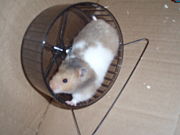
Like all pets, hamsters need exercise and entertainment to maintain their physical and mental health. Exercise wheels allow hamsters to run full speed, and are a common fixture in pet hamsters' enclosures. Choice tests have shown that adult Syrian hamsters prefer wheels that are as large as possible (they prefer a diameter of 35 cm over 23 cm, which itself is preferred over 17.5 cm); they also prefer a uniform running surface over rungs spaced 12 mm apart, but not over rungs spaced 9 mm apart.[4] Metal wheels with rungs should be avoided as the hamster can trap its leg in it resulting in injury or amputation. It is best to use a solid wheel. Olive oil (which is harmless to a hamster if ingested) can be used to lubricate the axle of the exercise wheel to reduce friction and cut down on turning noises when in use, vegetable oil can also be used in the same manner. Other common objects are plastic balls or cars that the hamster can be placed in so that they can be supervised while exploring outside their cage. Lack of exercises for a hamster may cause it to suffer from paralysis, and the affected hamster will have a hunched over posture.[5]
Hamsters are nest builders, so some owners supply twigs, leaves and wood bits so that they can build a secure spot in a corner or in their "house". Avoid using newspapers as the ink on it might be ingested when the hamster chews on them. Also avoid bleached-white toilet paper. Supplying strips of toilet paper can lead to stomach blockage and death after accidental ingestion by some hamsters. Hay is also a valuable building material for cozy hamster nests, but may pose the risk of having pesticides on it or sharp pieces that could cut or scratch the hamster. Therefore, select dry hay such as Timothy and use the softer, leafy parts of the hay rather than the stems. It is not advisable to use lint, as the hamster may consume it and the lint will block their intestinal passage. Fine chinchilla sand (not chinchilla dust because the powdery material will cause respiratory problems) can be given in an enclosed container. Hamsters enjoy rolling in the sand to keep their fur clean and dry.
Hamsters, like many rodents, are also gnawers, and must be supplied with appropriate materials for doing so; for example, an edible gnaw toy or an unpainted wooden block can be placed in the cage. Failure to do so can cause dental problems for the hamster, as the incisors, which grow continually, will become too long and cause discomfort and/or eating problems.
Food
Many hamsters tend to carry food from the source (by carrying it in their cheek pouches) and hoard it away in a cache hidden somewhere inside their container. Fresh vegetables and fruits, seeds, and insects like grasshoppers make up an important part of hamsters' natural diet. However, not all foods are suitable for hamsters and some, such as sweets made for humans or poisonous plants like the leaves of the tomato or rhubarb, are dangerous for hamsters. Citrus fruits such as oranges and lemons should never be fed to a hamster because their stomachs can not handle the acid. Iceburg lettuce has very little nutritional value and in excess can cause liver problems. Campbell's Dwarf Hamsters are susceptible to hereditary diabetes, and any hamster suffering from diabetes should not have high sugar foods, such as fruit and corn. If you feed your hamster cheese, or any other dairy product, it may get sick. Also, feeding hamsters stray leaves can be fatal.
In detail, the solid food components can be divided into three categories: dry, fresh, and animal food. Dry food generally makes up the bulk of a hamster's diet. Besides the standard rodent food sold in pet stores, most other kinds of seeds, kernels, and nuts can be given. Bird food like millet is a noteworthy alternative for small hamsters.
Sex and longevity

Syrian hamsters typically live no more than two to three years in captivity, less than that in the wild. Russian Hamsters (Campbell's and Winter White) live approximately 1.5 to 2 years in captivity, and Chinese Hamsters 2.5 to 3 years. The smaller Roborovski Hamster often lives to 3 to 3.5 years in captivity. Both Syrian and Russian hamsters mature quickly and can begin reproducing at a young age (4–5 weeks), whereas Chinese hamsters will usually begin reproducing at 2–3 months of age, and Roborovskis at 3–4 months of age.
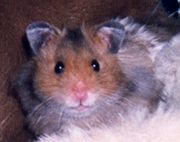
Left to their own devices, hamsters will produce several litters a year with several pups in each litter. Male and female hamsters are therefore usually kept in separate enclosures to prevent the addition of unwanted offspring. When seen from above, a sexually mature female hamster has a trim tail line; a male's tail line bulges on both sides. This might not be very visible in all species. Male hamsters typically have very large testes in relation to their body size. Before sexual maturity occurs at about 4–6 weeks, it is more difficult to determine a young hamster's sex. When examined, female hamsters have two holes close together, whereas males have anal and genital openings further apart than the female's. (The penis is usually withdrawn into the coat and thus appears as a hole or pink pimple.)
Health conditions
Relationships among hamsters
Neumann et al. (2006) conducted a molecular phylogenetic analysis of 12 of the above 17 species of hamster using DNA sequence from three genes: 12S rRNA, cytochrome b, and von Willebrand factor. They uncovered the following relationships:
- Phodopus group
The genus Phodopus was found to represent the earliest split among hamsters. Their analysis included both species. The results of another study (Lebedev et al., 2003) may suggest that Cricetulus kamensis (and presumably the related C. alticola) might belong to either this Phodopus group or hold a similar basal position.
- Mesocricetus group
The genus Mesocricetus also form a clade. Their analysis included all four species, with M. auratus and M. raddei forming one subclade and M. brandti and M. newtoni another.
- Remaining genera
The remaining genera of hamsters formed a third major clade. Two of the three sampled species within Cricetulus represent the earliest split. This clade contains Cricetulus barabensis (and presumably the related C. sokolovi) and Cricetulus longicaudatus.
- Miscellaneous
The remaining clade contains members of Allocricetulus, Tscherskia, Cricetus, and Cricetulus migratorius. Allocricetulus and Cricetus were sister taxa. Cricetulus migratorius was their next closest relative, and Tscherskia was basal.
Similar animals
Note that there are some rodents which are sometimes called "hamsters" that are not currently classified in the hamster subfamily Cricetinae. These include the Maned Hamster or Crested Hamster, which is really the Maned Rat (Lophiomys imhausi), although not nearly as marketable under that name. Others are the mouse-like hamsters (Calomyscus spp.), and the white-tailed rat (Mystromys albicaudatus).
See also
- Tales of the Riverbank
- The Hampster Dance
- Hamtaro
- Richard Hammond
References
Notes
- ↑ Doublas Harper, The Online Etymology Dictionary, s.v. "hamster" (2001) <http://www.etymonline.com>.
- ↑ Merriam-Webster's Collegiate Dictionary, s.v. "hamster" (May 29, 2008) <http://www.merriam-webster.com/dictionary/hamster>.
- ↑ 3.0 3.1 3.2 3.3 "hamster." Encyclopædia Britannica. Standard Edition. Chicago: Encyclopædia Britannica, 2007.
- ↑ Reebs, S.G., and St-Onge, P., 2005, Running wheel choice by Syrian hamsters, Laboratory Animals 39: 442-451.
- ↑ Hamster Hideout - Hamster Care - Ailments
Resources
- Lebedev, V. S., N. V. Ivanova, N. K. Pavlova, and A. B. Poltoraus. 2003. Molecular phylogeny of the Palearctic hamsters. In Proceedings of the International Conference Devoted to the 90th Anniversary of Prof. I. M. Gromov on Systematics, Phylogeny and Paleontology of Small Mammals (A. Averianov and N. Abramson eds.). St. Petersburg.
- Musser, G. G. and M. D. Carleton. 2005. Superfamily Muroidea. In Mammal Species of the World a Taxonomic and Geographic Reference (D. E. Wilson and D. M. Reeder eds.). Johns Hopkins University Press, Baltimore.
- Neumann, K., J. Michaux, V. Lebedev, N. Yigit, E. Colak, N. Ivanova, A. Poltoraus, A. Surov, G. Markov, S. Maak, S. Neumann, R. Gattermann. 2006. Molecular phylogeny of the Cricetinae subfamily based on the mitochondrial cytochrome b and 12S rRNA genes and the nuclear vWF gene. Molecular Phylogenetics and Evolution, in press; Available online 17 February 2006.
External links
|
|||||